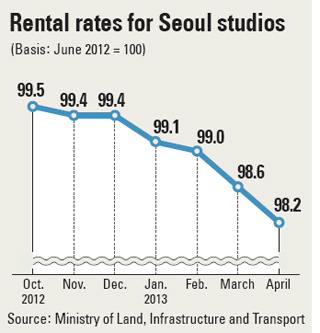Investors in studio flats see room for improvement

A 51-year-old housewife surnamed Seo is concerned about her initial plan for the post-retirement life as returns on investments from studio flats are likely to continue falling. She planned to build a studio-building in Mok-dong, western Seoul, and rent flats to receive monthly fees after her husband retires. However, what she hears from the news media is that profits from studios are decreasing.
Lee, 48, bought a 23-square-meter (237-square-foot) flat for 200 million won ($183,000) in Yeoksam-dong, southern Seoul, in 2010, with high expectations of extra income. Although the flat was completed two months ago, he hasn’t found a tenant.
“I thought the rate could be about 900,000 won per month with a deposit of 10 million won, but the market price now hovers at about 750,000 won,” he said. “The annual yields from the flat are estimated to be less than 4 percent, while I was expecting over 6 percent.”
Until last year, studios were a popular investment item due to the country’s increasing number of one-person households. But the trend seems to be changing since the government tightened rules and the studio market reached saturation due to an oversupply of properties.
“The government regulations and supply glut are two major factors that depress the market,” said Hong Seok-min, head of the real estate research center at Woori Bank.
The government’s rule on garages at studio buildings is considered the biggest hindrance to investors. From July, owners of studio buildings are required to supply parking spaces for studios that are 30 square meters or less. Until recently, only owners of studios larger than 60 square meters had to provide spaces.
The new regulation reduces profits for studio owners by around 30 percent, according to a construction company, because the rule limits the number of studio flats allowed to be built on a particular site.
Excess supply is another problem for investors. According to Real Estate 114, a market researcher, the total number of studios in Korea had been about 7,700, but the figure surged to 32,000 this year.
The Korea Appraisal Board said prices of studios in Seoul fell 1.19 percent last month compared to last June.
According to financial information provider FR Investment, the average returns on investment (ROI) of studios in the capital city dipped 0.14 percentage point to 5.63 percent in the first quarter of the year. A year earlier, the ROI stood at 6.18 percent.
“In the three Gangnam districts - Seocho, Gangnam and Songpa - where new studio buildings sprang up, investors saw yields drop by more than 0.2 percentage point in the past three months,” said Ahn Min-seok of FR Investment.
Experts foresee that since more studios are scheduled to be completed this year, the average ROI is likely to continue its downward trend.
The total number of studios in the country is estimated to reach 39,000 with an additional 7,700 studios expected to be built next year.
By Choi Hyun-joo [ssh@joongang.co.kr]










with the Korea JoongAng Daily
To write comments, please log in to one of the accounts.
Standards Board Policy (0/250자)